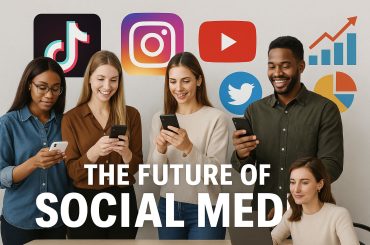In 2025, social media has evolved into far more than a platform for engagement—it’s a full-scale marketing engine driving direct conversions, brand affinity, and long-term loyalty. While the fundamentals of social media remain rooted in communication, the strategies required to succeed have shifted dramatically.
Today’s audiences are more discerning, algorithms are more sophisticated, and competition is more intense than ever. Therefore, brands must employ precise, data-informed strategies that prioritize genuine value, personalized content, and measurable outcomes. Below is a comprehensive analysis of the most effective social media marketing strategies for 2025, designed for businesses that aim to move beyond impressions and into conversion-driven success.
1. Content Personalization at Scale
The era of one-size-fits-all content is over. With access to refined user data and AI tools, brands can now segment their audiences not only by demographics, but by behaviors, purchase intent, content interaction patterns, and even mood indicators.
Strategy in Action:
- Use AI-driven content tools to tailor variations of the same post to multiple micro-segments.
- Deploy dynamic creative optimization (DCO) in paid campaigns to test and serve high-performing versions to specific audiences.
- Customize messaging across platforms—what converts on Instagram Reels may not work on LinkedIn.
Why It Converts:
Personalized content delivers 2–5x higher engagement and improves click-through rates by anticipating user needs and preferences.
2. Video-Led Storytelling
Short-form video is not merely a trend—it is now a cornerstone of conversion strategy. In 2025, platforms like TikTok, Instagram Reels, and YouTube Shorts dominate attention spans. However, the focus has shifted from viral entertainment to brand-led storytelling that encourages specific action.
Strategy in Action:
- Produce 15–60 second videos with a clear problem-solution structure.
- Feature real customers or creators explaining product impact.
- Embed soft CTAs mid-video instead of relying on end-screen prompts.
Why It Converts:
Video content captures attention more effectively, builds trust faster, and drives higher engagement—particularly when it mirrors user-generated formats.
3. Strategic Influencer Collaborations (Not Just Sponsorships)
The influencer landscape in 2025 prioritizes strategic partnerships over simple endorsements. High-converting strategies focus on deep alignment between brand values and influencer personas.
Strategy in Action:
- Co-create product bundles, limited editions, or service experiences with influencers.
- Provide influencers with creative autonomy while aligning on brand messaging.
- Use affiliate or performance-based compensation models to tie results to revenue.
Why It Converts:
Influencers serve as a bridge of trust. Strategic partnerships feel authentic and personalized, significantly improving conversion rates compared to direct ads.
4. Seamless Social Commerce Integration
Most major platforms now support native checkout or third-party integrations. In-platform shopping minimizes friction and supports impulse decision-making.
Strategy in Action:
- Set up native shops on Instagram, TikTok, and Facebook.
- Use product tagging in all visual and video content.
- Promote limited-time offers or drops directly within content and livestreams.
Why It Converts:
Removing steps from the purchase journey increases the likelihood of conversion—especially among mobile-first shoppers.
5. First-Party Data Collection via Engagement
With increasing privacy restrictions, first-party data is now a brand’s most valuable asset. Social media is a powerful channel for gathering this data through interactive content.
Strategy in Action:
- Run quizzes, polls, and interactive stories to gather preferences.
- Offer gated value content (guides, webinars, discounts) in exchange for email/SMS opt-in.
- Integrate CRM tools to track user interactions across touchpoints.
Why It Converts:
First-party data allows for more accurate retargeting and better personalization, both of which drive higher conversion rates.
6. Community-Centric Campaigns
In 2025, social media is less about broadcasting and more about building digital communities. Brands that prioritize connection over conversion often convert more—paradoxically—because trust drives transactions.
Strategy in Action:
- Create niche Facebook Groups, Discord servers, or subscriber-only Instagram channels.
- Host live AMAs (Ask Me Anything), behind-the-scenes sessions, or community feedback events.
- Reward loyalty through exclusive content or early access to products.
Why It Converts:
Communities foster long-term loyalty and significantly improve lifetime value (LTV), while reducing cost-per-acquisition (CPA) through organic advocacy.
7. Analytics-Driven Iteration
Every high-performing campaign in 2025 is grounded in data. Sophisticated analytics tools help marketers isolate what truly drives conversions, from timing to tone to visuals.
Strategy in Action:
- Use heatmaps, engagement metrics, and A/B testing to refine messaging.
- Track performance across the entire funnel, not just top-of-funnel metrics.
- Implement AI tools that auto-optimize based on real-time results.
Why It Converts:
Data-informed decisions prevent wasted budget and allow for agile, responsive campaigns that evolve in real time to audience preferences.
8. Cross-Platform Funnel Synchronization
Audiences don’t live on a single platform—and neither should your strategy. Cross-platform funnels ensure that each stage of awareness, engagement, and conversion is covered through coordinated touchpoints.
Strategy in Action:
- Use Instagram Reels for discovery, LinkedIn for authority, and email for conversion—all tied into one journey.
- Ensure retargeting pixels and event tracking are consistently applied across all channels.
- Use storytelling themes that carry across platforms but adapt tone per audience segment.
Why It Converts:
A unified journey ensures consistent brand perception and makes each touchpoint more effective in guiding the user to conversion.
Conclusion
Social media marketing in 2025 demands more than creativity—it demands precision, authenticity, and strategic alignment. Brands that convert consistently are those that integrate storytelling with technology, data with emotion, and personalization with scale.
Success lies not in chasing trends but in building systems that respond to what audiences truly want: value, clarity, and connection. As we move deeper into this era of digital maturity, marketers who build trust first and optimize intelligently will find that conversions naturally follow.




